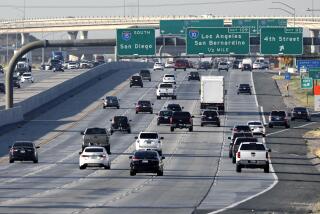U.S. Traffic Deaths Down in 2003
- Share via
WASHINGTON — Bucking a five-year trend of increased fatalities on the nation’s roads, the number of people killed in car crashes dipped in 2003 and the number of injuries was the lowest since record-keeping began, the federal government reported Tuesday.
In California, though, deaths continued to rise, increasing last year by 3.1%.
Nationwide in 2003, road accidents caused 42,643 deaths -- 362 fewer than in 2002 -- and about 3 million injuries, according to the National Highway Traffic Safety Administration.
Officials called America’s roads and highways safer than ever and said that the nationwide rate of fatalities was the lowest ever recorded -- 1.48 deaths per 100 million miles driven, the first time the rate had dropped below 1.5. Americans drove about 2.88 trillion miles last year, up from about 2.86 trillion in 2002.
California, which has more cars and drivers than any other state, led the nation in the number of road fatalities last year with 4,215 deaths, compared with 4,088 in 2002.
The state’s road fatalities dropped by about a third from 1990 to 1998. This drop coincided with the state mandating in 1992 that anyone not wearing a seat belt could be cited by police. State officials now estimate that more than 90% of drivers and passengers buckle up.
In recent years, the number of deaths on California roads has been creeping back up -- increasing 21% since 1998.
Steve Kohler, a California Highway Patrol spokesman, said speeding and drunk driving remain problems. In 2001, one-third of all fatal car accidents were alcohol-related, according to the CHP.
Based on other statistics, though, California is safer than the rest of the country. The NHTSA has not released figures on California’s rate of fatalities for last year. But in 2002, for every 100 million miles traveled in a vehicle, California’s fatality rate was 1.27, lower than the nationwide figure of 1.5. The state’s number of deaths, given its population, was also better than the national rate.
The nationwide numbers released Tuesday were a surprise because officials had estimated in April that the number of fatalities in 2003 would be the highest in 13 years. That estimate was based on projections rather than actual figures, which take longer to compile from local officials.
NHTSA administrator Jeffrey Runge said Tuesday that increased seat belt usage might have contributed to the lower number of lives lost. In 2002, 59% of those killed in car crashes were not wearing seat belts. Last year, that figure dropped to 56%.
Some safety advocates warned that the government was exaggerating the progress made and that certain other trends were alarming.
“We think we’re just running in place,” said Gerald Donaldson, senior research director for Advocates for Highway and Auto Safety, an alliance of consumer groups, health and safety groups and insurance companies. “I don’t think we’re making tremendous gains. I think we’re on a treadmill.”
Motorcyclist fatalities nationwide rose to 3,661, an increase of 12%. Deaths from vehicle rollovers declined by 3.3%, but the number related to sport utility vehicles jumped by 6.8%, to 2,639. Rollover crashes account for 3% of all accidents, but they represent one-third of all highway fatalities.
Runge said certain trends, such as the rising number of older motorcycle riders, made it difficult to keep roads safe.
“We realize we are swimming very hard against some currents that are getting faster and faster,” Runge said.
States with the biggest percentage decreases in fatalities included Colorado and Vermont, which dropped 15% and 12%. In addition to California, Rhode Island, Oregon and the District of Columbia saw increases in deaths. In the nation’s capital, fatalities increased by 43%.
More to Read
Sign up for Essential California
The most important California stories and recommendations in your inbox every morning.
You may occasionally receive promotional content from the Los Angeles Times.










